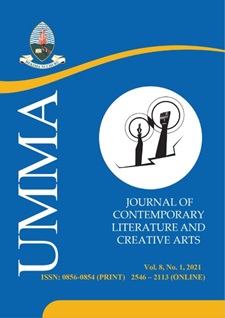Twinship Trope and the Creation of a Hybrid Space in Beyonce Knowles’ Maternity Photo Album
Abstract
This article seeks to unveil the figurative expression of the feelings of the mixed-race artist towards a hybrid identity. It examines Beyonce Giselle Knowles's Maternity Photo Album with the paratext of Warsan Shire’s poem, “I Have Three Hearts,” to reveal the quest for identity negotiation for mixed-race artists with African ancestry. From a postcolonial lens, particularly based on Homi Bhabha’s theory of “the third space,” this examination reveals how Knowles’ maternity photo album serves as an allegorical interpretation of Shire’s “I Have Three Hearts.” Through this examination, it emerges that Shire’s poem exposes the shared experiences of the African descendants in the diaspora. As the two rise from the shadows of their parents, mixed-race artists occupy an ambivalent space bearing dual identities: those of their parents and their own, whether African-Americans or Black Britons, as it appears in this case. Therefore, their living abroad creates a sense of longing for their missing African part to the extent that they seek to affiliate themselves with this lost part through their work. Hence, by doing so, they recreate a space that is integral and complete on its own. This article, therefore, treats Knowles’ pregnancy with twins as a telling metaphor for biracial identity. The examination unfolds Knowles’ allegorical interpretation of Shires’ poem whereby Twinship serves as a trope for negotiating a space for hybrid identity.
Keywords:
Twinship trope, allegory, and hybridity
References
Abrams, M.H. A Glossary of Literary Terms. Boston: Heinle and Heinle, 1999 Print.
Anyanwu, Chukumwa. "Traditional Values Versus Modernity: A Resolution of the Dilemma of Culture Conflict in African Society" in International Journal of African Society, Culture and Traditions Vol.3 No.4 pp (12-21), European Centre forResearsch and Development: UK, 2015. Print.
Bahba, Homi. The Location of Culture. New York: Routledge, 1994. Print.
Bastian.L. "The Demon Superstition": Abominable Twins and Mission Culture in Onitsha History. Ethnology, Vol.40, No. 1, Reviewing Twinship in Africa: USA, University of Pittsburg. 2001 Print.
Cooper, Brenda "Diaspora Gender and Identity: Twinning in Three Diasporic Novels" English Academic Review 2008 25.1, pp 51-65.
Culler, Jonathan. Literary Theory A Very Short Introduction. USA. Oxyford University Press, 1997. Print.
Cuder, Dominguez, P. "Double Consciousness in the Work of Helen Oyeyemi and Diana Evans." Women: a Cultural Review.20.3:2009: 277-286. Web. 2010.
DuBois, W.E.B. The Souls of Black Folk: In Three Negro Classics (207-389). New York: Grove Press. 1965 .Print.
Emecheta, Buchi, Kehinde. Waveland: 1996 Long Grove Print.
Evans, Diana , 26a, London, Chatto and Windus: 2005 Print.
Fanon, Frantz. The Wretched of the Earth. Harmondsworth:1967 Penguin.
Fernandez, Irene P. " Embodying Twoness in Oneness" in Diana Evan ' s 26a Published Online: 2012 Print.
Gans, H. J. (1996) Symbolic ethnicity: The future of ethnic groups and cultures in America. In W. Sollars (1996), Theories of ethnicity: A classical reader (pp. 425-459). New York: New York University Press.
Ilott, Sarah. "Fragmenting and Becoming Double": Supplementary twins and abject bodies in Helen Oyeyemi ' s The Icarus Girl". (2016). Journal of Commonwealth Literature, vol.51 (3).402-415.
Knowles, Beyonce , Lemonade, Parkwood.Columbia (2016). Recorded.
Leroy Fernand et al "Yoruba Customs and Beliefs Pertaining to Twins" Twin Research Volume 5.2 (pp. 132-136). 2002
Lundel, Ase, "Jess-Who- Wasn ' t €“Jess" Double Consciousness and Identity Construction in Helen Oyeyemi ' s The Icarus Girl" Ariel Review of International English Literature 2011. Vol41 No.2 (pg 89-112).
Odugyang, Esi, The Second Life of Samuel Tyne, Canada: Vintage, 2005, Print.
Oruene, T, "Magical Powers of Twins in the Socio- Religious Beliefs of the Yoruba, Folklore: 1985" 96.2, pp. 208-16.
Oruene, T, "Magical Powers of Twins in the Socio- Religious Beliefs of the Yoruba, Folklore: 1985" 96.2, pp. 208-16.
Oyeyemi, Hellen. The Icarus Girl. New York: 2006. Anchor Books. Print
Oyeyemi, Hellen. White is for Witching. London. 2009. Deckle Edge. Print
Renne, E. Twinship in an Ekiti Yoruba Town, "Ethnology: 2001.40.1, pp.63-78.
Shildkroud E. People of the Zongo.C.U.P, London: Cambridge, 1978. Print
Smith, Robert S. Kingdoms of Yoruba. London: Methuen, 1969.Print
Stouck Jourdan, "Abjecting Hybridity in Hellen Oyeyemi ' s The Icarus Girl, Areal Review of International English Literature (2001). Pg 89-112.
Tyson, Louis. Critical Theory Today: A User Friendly Guide (2nd ed) .New York: Routledge, 2006. Print
Soyinka, Wole. "Becoming Nigerian"Africa States of Independence Nigeria, September 2010. Web.June.2017
BBC World Service. "The Land of Twins", June 2001, www.bbc.co.uk/ world service/people/highlights/010607-twins.shtml
"Biography" at http: // www.biography.com/ people/Nefertiti-9421166, access date September 19, 2017, A&E Television Networks.
Garcia, Brittany in Ancient History Encyclopedia in http://www.ancient.eu/user/ucr_penguin/ visited in 20/09/2017.
Smith, Cate, "All About the Color Purple" in www.sensationalcolor.com/color-meaning/color-meaning-symbolism-psychology/all-about-the-color-purple-4329#.WcDeT9FRXIU visited in 19/10/2017
Wade, Lisa, Is Beyonce "Black?" on February 2011 at https://thesocietypages.org/socimages/2011/02/24/is-beyonce-black/ visited on 11/09/2017
Welcome to the Yoruba Religious Concepts, Understanding the belief concepts of the Lucumi faith in http://sites.google.com/site/theyorubareligiousconcepts/ osun-gives-birth visited 10/09/2017
Downloads
Published
Issue
Section
License
Copyright (c) 2024 Creative Commons

This work is licensed under a Creative Commons Attribution-NoDerivatives 4.0 International License.
- Authors retain copyright and grant the journal right of first publication with the work simultaneously licensed under a Creative Commons Attribution License that allows others to share the work with an acknowledgement of the work's authorship and initial publication in this journal.
- Authors are able to enter into separate, additional contractual arrangements for the non-exclusive distribution of the journal's published version of the work (e.g., post it to an institutional repository or publish it in a book), with an acknowledgement of its initial publication in this journal.
- Authors are permitted and encouraged to post their work online (e.g., in institutional repositories or on their website) prior to and during the submission process, as it can lead to productive exchanges, as well as earlier and greater citation of published work (See The Effect of Open Access).



